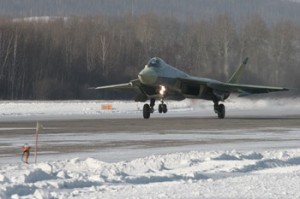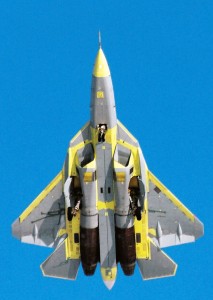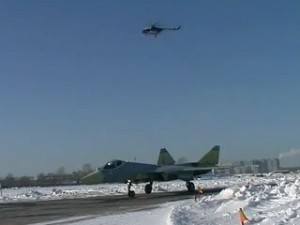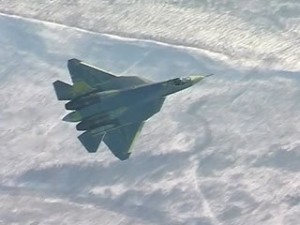 The Sukhoi PAK FA (or PAK-FA or T-50 ) is a fifth-generation fighter which is being developed by Russia. PAK FA stands for Perspektivnyi Aviatsionnyi Kompleks Frontovoi Aviatsyi which basically means Advanced Tactical Frontline Fighter.PAK FA is being developed by a consortium of companies spearheaded by Sukhoi OKB. Sukhoi’s internal project codename is known as T-50. The PAK FA is intended to replace the MiG-29 Fulcrum and Su-27 Flanker in the Russian Air Force. It is scheduled to have its first flight in 2009 and enter service with the Russian Air Force subsequently. It is designed to compete with US F-22 Raptor and F-35 Lightning II.
The Sukhoi PAK FA (or PAK-FA or T-50 ) is a fifth-generation fighter which is being developed by Russia. PAK FA stands for Perspektivnyi Aviatsionnyi Kompleks Frontovoi Aviatsyi which basically means Advanced Tactical Frontline Fighter.PAK FA is being developed by a consortium of companies spearheaded by Sukhoi OKB. Sukhoi’s internal project codename is known as T-50. The PAK FA is intended to replace the MiG-29 Fulcrum and Su-27 Flanker in the Russian Air Force. It is scheduled to have its first flight in 2009 and enter service with the Russian Air Force subsequently. It is designed to compete with US F-22 Raptor and F-35 Lightning II.
The PAK FA will feature a long combat radius, supersonic cruise speed, low radar cross section, super maneuverability, and the ability to make short takeoffs and landings. In accordance with the technical requirements, the PAK FA will have a normal takeoff weight of 20 tons, which is close to the average normal takeoff weight of the two US stealth airplanes, the F-35 JSF (17.2 tons) and the F-22 Raptor (24 tons). The PAK FA will be created using Stealth technology, and equipped with two AL-41F engines by the Saturn scientific and industrial enterprise, a radar system with an active phased array (to all appearances, it will be produced by the Fazatron-NIIR corporation), and high-precision weapons.
The PAK FA is an intermediate class twin-engined fighter and will be larger than a MiG-29 and smaller than a Su-27. The PAK FA is intended to be about the same size as US F-35 JSF, with a primary air superiority mission and ground attack and reconnaissance being secondary missions.
The government commission decided on 26 April 2002 to choose the Sukhoi holding company as the head company to develop and produce PAK FA . The prototype of the PAK FA would take-off in 2006 and that in 2010 the aircraft would be ready for series production. The first deliveries, both for Russian armed forces and for export, would be possible in 2011-12.
This new stealth aircraft is being proposed to be brought from the concept design to a prototype series in less than 9 years. Historically, fourth and fifth generation fighters have not been created in less than 15 years. The Russian government has promised to allocate 1.5 billion dollars for the PAK FA through 2010. But the Russian Air Force is receiving less than 200 million dollars a year during this period, and will spend it primarily on other needs.
The prices and sources of funding will determine the destiny of the whole program. Presently the officials agree that the program will cost about $1.5 billion. However, $1.5 billion is the sum needed for creating a new generation of avionics for the fighter (considering the fact that pre-production models of the phased array have already been produced, and will soon be tested). Completion of the AL-41F engine (present readiness is 30 percent) will require, in the opinion of the boss of Rosaviakosmos, 600 – 800 million dollars. Saturn said that launching of production of the AL-41F engine would take $150 million. An improved version of the AL-31F will be used on the aircraft originally (though it is not clear how these heavy motors are reconciled with the concept of a 20-ton fighter). The upgrade of these engines will require expenditures of 1.2-1.5 billion dollars. And finally, designers will have to spend several hundred millions of dollars on creating a new airframe.
State financing will cover not more than 20-22 percent of the cost of the development of the PAK FA. It will thus be necessary to draw extra budgetary sources of funding, lending the development program a principle of openness for international cooperation. The plane’s development will be conducted with a view of achieving a reasonable compromise between its cost and combat efficiency, and take into account the market demand.Exports sales of the new warplane must reach 500 to 600 fighters at a price of $35 to $40 million each to make production of the new aircraft profitable.

According to some reports, India and Russia have agreed to jointly develop this fifth-generation fighter, under a scheduled timeframe with entry into service in 2009. This would be the first such joint development venture between the two countries.
There is little chance that Russia will have fifth-generation pursuit planes of its own. Development and construction of a fifth-generation fighter would require about $20 billion dollars, and as of early 2004 it was unlikely that the government will appropriate financing of this scale. “The problem is that economic and military authorities in this country live in parallel spaces and have no common approach to problems,” according to Deputy Director of the analytical department of the Political and Military Analysis Institute Alexander Khramchikhin.
Maiden flight:
On December 8, 2009, Deputy Prime Minister Sergei Ivanov announced that the first trials with the fifth-generation aircraft would begin in 2010. The testing, however, has commenced earlier than stated, with the first successful taxiing test taking place on December 24, 2009. The aircraft’s maiden flight took place on 29 January 2010 at KnAAPO’s Komsomolsk-na-Amure Dzemgi Airport; the aircraft was piloted by Sergey Bogdan and the flight lasted for 47 minutes.





No comments:
Post a Comment